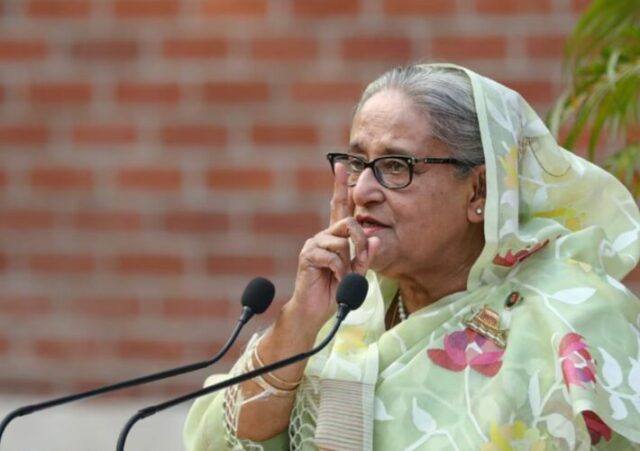The Indian mission in Dhaka is in a reboot mode now. Exactly a week after Sheikh Hasina, undisputed strongwoman of Bangladesh for a decade and a half, had to leave the country in a hurry, the Indian diplomatic and security establishment has taken steps to reach out to the new dispensation.
Pranay Verma, India’s High Commissioner to Bangladesh, met Mohd Yunus, the head of the interim government in Dhaka, immediately after he took oath on Thursday night. In a way, it suits India that an ‘inclusive’ advisory council backed by the military is at the helm in the interim.
Had it been a government purely headed by a political party such as the Bangladesh Nationalist Party (BNP) or a BNP-led coalition that included the radical Jamaat-e-Islami, it would have been all the more difficult for New Delhi to build bridges with the new dispensation. From 2009 onwards, India was perceived as fully backing Sheikh Hasina and her party, the Awami League, to the exclusion of other political forces.
Despite attempts at outreach to India by both the BNP and the Jamaat since 2011—in the immediate aftermath of then Prime Minister Manmohan Singh’s visit to Dhaka—their leaders were rebuffed both by the UPA and the Modi government in the past 10 years. Indian decision-makers had not forgotten the history of hostility and anti-India activities encouraged by the BNP-Jamaat coalition during their rule. Insurgent groups in India’s north-east had a free run in Bangladesh rule and it was not until 2011-12 that top leaders—from the United Liberation Front of Asom (ULFA), National Democratic Front of Bodoland (NDFB), United Nationalist Liberation Front (UNLF) to name a few—were rounded up and handed over after joint operations by Bangladeshi and Indian intelligence operatives.
Indian diplomats based in Dhaka and some old hands in the security establishment may have to work extra hard to reach out to the new power centres in Bangladesh. However, Mohd Yunus is not a stranger to Indians, although the preliminary assessment in New Delhi about Yunus’ ability to lead the motley group of advisers in the interim government is one dominated by scepticism. That he has never worked in the government is one aspect, the other is his western orientation and lack of deep connect with the rest of the group of advisers. The question uppermost in everyone’s mind is about his ability to control the extreme views of some of his colleagues on the advisory council.
The only positive for India at this moment is the professional and cordial relationship it enjoys with the current military leadership in Bangladesh which—so far—does not see India in adversarial terms. Throughout the crisis in the last few weeks of the Hasina government, Indian and Bangladesh military and intelligence establishments were in constant touch with each other in addition to the usual diplomatic exchanges.
A 15-year-old emergency evacuation plan for the deposed Prime Minister was reviewed and updated during this period, considering the gravity of the situation. The plan was put in place immediately after the BDR mutiny in February 2009 which was seen as a conspiracy to harm Hasina and destabilise the newly installed government by a combination of internal and external forces. Standard Operating Procedures for emergency situations like the one in 2009 and on August 4-5 earlier this month involved Hasina and her immediate family to be extracted via Bangladesh Air Force helicopters or transport planes and discussing the possibility of allowing Indian Air Force planes to land at other air bases near towns in which Indian consulates are located in Bangladesh to evacuate Indian diplomatic staff and their families.
Eventually, only the deposed Prime Minister and her sister were flown out by the Bangladesh Air Force C-130 plane which was allowed to land at the Hindon Air base near Delhi on August 5. Plans to evacuate Indian diplomats by IAF planes were abandoned because there was no guarantee of safe passage through the streets of these towns or even Dhaka when mobs were on the rampage on August 5 and 6. On August 5, Bangladesh Army authorities deployed Armoured Personnel Carriers (APCs) around the Indian mission in Dhaka and sent reinforcements to guard the compound since for a while it appeared that the mobs would try to attack the Indian High Commission. Some inputs also suggest that senior Indian diplomats were also taken to the Army Cantonment for a couple of days as a precautionary measure.
Days before Sheikh Hasina flew out, Indian interlocutors, keeping a close watch on the deteriorating situation, had reportedly advised her closest advisers to adopt a conciliatory approach towards the protesting students. She was, however, not inclined to back down, repeatedly hinting at a conspiracy to oust her. That she saw a clear U.S. hand behind the protests is now borne out by the text of her planned address to the nation, accessed by the Economic Times. She pointed at a U.S. hand in the regime change since she apparently did not agree to hand over St Martin’s island (a strategically located piece of land in the Bay of Bengal) to the Americans. (The ET report has since been denied by her son)
On the morning of August 5 too she was determined to stay on and even her sister Rehana or Army Chief Gen Wakar-uz-Zaman were unable to convince her about the need to leave. Ultimately, the Army Chief got on the phone with her son Sajeeb Wajed Joy based in the U.S. to make him aware of the threat to his mother’s life. It was eventually Joy who persuaded Hasina to quickly exit.
What does the future hold for Hasina? That she has been allowed to stay back indicates that India is not averse to her presence in the country, at least in the short term. Whether she would go back to Bangladesh is not clear although her son Joy seems to hint at a comeback. For India, the golden era in the chequered relationship is over. It is now time to look ahead and build relationships anew. The challenge for Indian diplomacy in the coming months is formidable. But as the reality of governing a complex country hits the new dispensation, it will realise that geographic proximity to India cannot be wished away.
Nitin A. Gokhale is a media entrepreneur, one of South Asia's leading strategic affairs analyst and author of over a dozen books so far on military history, insurgencies and wars.
Starting his career in journalism in 1983, he has since led teams of journalists across media platforms.
A specialist in conflict coverage, Gokhale has covered the insurgencies in India’s North-East, the 1999 Kargil conflict and Sri Lanka’s Eelam War IV between 2006-2009.
Gokhale now travels across the globe to speak at seminars and conferences, and lecture at India’s premier defence colleges. He has founded three niche portals, Bharatshakti.in, stratnewsglobal.com and Interstellar.news.





